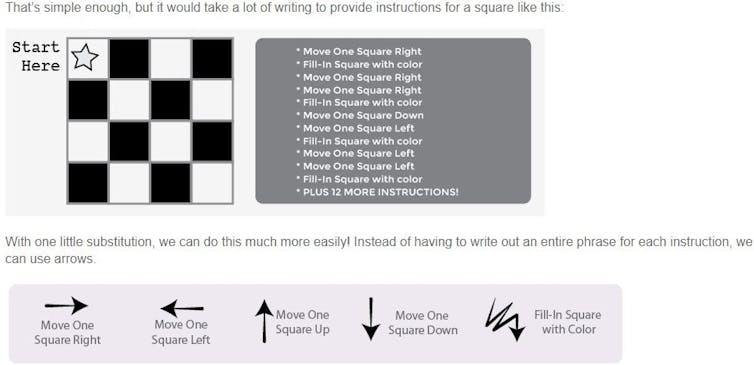Why a computer isnÔÇÖt the first thing you need when teaching kids to code
December 14, 2020
Share

In 2020, COVID-19 hit, and globally, there was . Educators and parents realized that going forward, now that school boards have invested heavily in remote learning it .
 Some people have surely been impressed by what even the youngest learners can do with technology. At the same time, itÔÇÖs also who can create whatever will supersede the huge tech platforms of our day like Google or TikTok.
Some people have surely been impressed by what even the youngest learners can do with technology. At the same time, itÔÇÖs also who can create whatever will supersede the huge tech platforms of our day like Google or TikTok.
But success in teaching children coding is not about choosing the most cutting-edge technologies or programs. It is about all the learning that is critical as a foundation. Children must learn to locate and orient themselves and other objects in space, and how to visualize such movements and relationships. They must also learn how to communicate and how to solve problems.
Human cognition drives code and, by extension, the computer. ItÔÇÖs the human cognition manifest in wondering, learning to pose problems and ÔÇ£debugÔÇØ solutions that we should be most concerned with.
Roots of coding
A practical pre-coding resource, aptly named The Roots of Coding, is under development (for early 2021 release) by the experienced educators focus team, which I lead. This network is a coalition of Ontario-based .
With this resource, educators will find a guide for drawing on music and dance, acting games and other multi-sensory approaches to help children learn how to talk to their peers. The source provides curriculum for guiding children in learning to move their own bodies in relationship to others ÔÇö and then, how to build models based on instruction.
This resource teaches foundational .
Computational thinking
At its core, is about communication. Computers act in response to instructions. If you think conveying clear directions is simple, watch the ÔÇ£Exact Instructions ChallengeÔÇØ with YouTuber Josh Darnit and his children. They attempt to to make a peanut butter sandwich by following apparently direct instructions with precision.
YouTuber Josh DarnitÔÇÖs ÔÇÿExact Instruction Challenge.ÔÇÖ
To learn computational thinking, children must learn to make their abstract problems, knowledge, processes and solutions clear and systematic enough so that they are available to other students, open for discussion and debate. They must learn how to express and share .
Existing coding support
In Canada, we have been fortunate to have a national program .
The program has funded projects such as , and . These provide kindergarten to Grade 12 students and teachers with opportunities to learn digital skills including coding, data analytics and digital content development. These complement and supplement .
Programs like these employ programmable robots and free, user-friendly computer languages like and to bring coding into homes and classrooms.
MIT media lab video about Scratch.
Such programs make it possible for even the youngest children to successfully instruct a computer to act in a specific way (the definition of computer programming) by following a particular sequence of instructions.
Lessons from LOGO
More than , computer scientists at MIT developed the to teach children the fundamentals of computer programming. Children could explore how commands work through drawing geometric shapes, solving math problems and creating games. LOGO was .
But as teaching and learning researcher P. Gibbons notes in the essay ÔÇ£Logo Learning: What the Learners Say,ÔÇØ in the collection , there was some notable resistance from educators and parents who thought learning LOGO would have no lasting benefit because so-called ÔÇ£realÔÇØ programmers didnÔÇÖt use LOGO and it was just for kids.
Today, Andreas Schleicher, director of education and skills for the OECD, has suggested that because coding is a ÔÇ£ÔÇØ that will quickly become obsolete.
What such criticisms of teaching LOGO and coding miss is that the benefit of learning either at school isnÔÇÖt foremost about early workforce technical instruction. Rather, itÔÇÖs about children learning thinking and problem-solving that will be transferable.
Computer scientist Cynthia Solomon, one of the creators of LOGO, explains its history, development and uses.
Learning to code is like learning to read: recognizing letters and symbols, sounding out words and making sentences. But the true power of learning to read . Similarly, the true power of learning to code is when children apply the thinking and problem-solving they learn through coding, what might be called .
Tactile learning, embodied games
There are ways to prepare children for coding that are accessible to classroom teachers with limited (or no) knowledge about coding.
Games such as four squares, hopscotch and Simon Says are about learning spatial orientation or visualization in relationship with others and how to follow instructions.
For young children, computational thinking activities begin in concrete and tactile ways. For example, children can be instructed to make a :

When children are challenged to break down a complex task of their own choice, they intentionally take charge of their own learning. Cultivating this impulse is a central tenet and a fundamental .
By focusing on the process of generating, concretizing and evaluating their ideas, children can become more skilled at thinking .
When students can recognize that there are multiple correct solutions, and many unique and creative answers, this results in . It leads to new opportunities to play with and ÔÇ£chew onÔÇØ emergent, collective and creative ideas.
In the end, itÔÇÖs todayÔÇÖs creative problem solvers who will be the true powerful technologies of the future.![]()
______________________________________
, Professor of Elementary Mathematics, .
This article is republished from under a Creative Commons license. Read the .